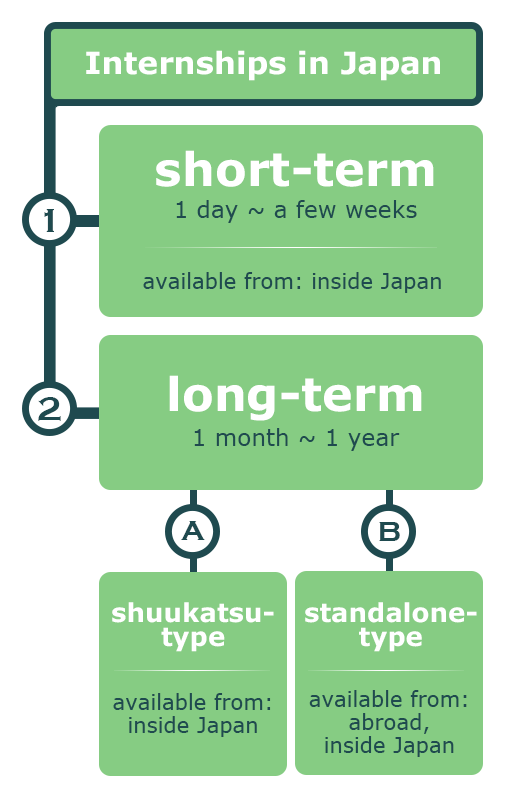Internships in Japan for Foreigners and How to Find them

by Florian
Searching for an internship in Japan can be confusing. In this article, we fill you in on everything on everything you need to know: From language requirements to different internship options to how to find the internship of your choice – both from abroad and from inside Japan.
コンテンツ
The Japanese Internship System
Internships in Japan are not all the same. In addition to being paid or unpaid, they differ in purpose, duration, workload, and visa sponsorship availability. Because they’re all lumped together under the term “internship,” it can be hard to find precisely what you are looking for.
Before we go into how to find internships, let’s have a look at the different types to clear up the confusion. For starters, here’s a simple overview (we’ll go into the details below):
Short-Term Internships
Most internships that you’ll see advertised in Japan are of the short-term variety (sometimes called event-type internships). They run from 1 day to a few weeks and are more or less glorified workplace tours. In the 2019/20 job hunting season, these short-term programs made up a whopping 88% of all internships offered by companies, and around 60% of them were single-day events (according to Recruit’s “Job Hunt White Paper for 2020”).
Common contents of short-term internships are:
- – Seminars
- – Group discussions and other group activities
- – Q&A sessions with employees
- – Tours through the company building(s)
Because of their short duration and the fact that the “interns” aren’t doing any work, these internships are usually unpaid and treated as networking opportunities. They can be useful to get in touch with a company and the people working there before the start of the recruitment season. This can give you the upper hand in the selection process later on. They’re also an easy way to scout out whether the general vibe of a company matches your expectations.
According to data collected at Rikunabi, short-Term internship attendance peaks in August and February. These are called summer internships and winter internships respectively, and application deadlines are usually 2 months in advance – in June and December. Needless to say, there’s no visa sponsorship for this type of internship.
Long-Term Internships
This is the type of “proper” internship you’re probably used to from your home country. Running from anywhere between 1 to 6 months (and even longer in some cases), these internships serve the purpose of making students familiar with practical work tasks. There are full-time and part-time variants.
Long-term internships are still in the minority in Japan. In 2019/20, only 0.5% of internships were of the long-term variety (1 month and longer), and only around 5% of surveyed students answered that they did one (according to Recruit’s “Job Hunt White Paper”).
Note that these numbers are probably a bit lower than they really are. For one, only a fraction of companies in Japan is reflected in Recruit’s survey. Also, some Japanese companies don’t do internships but accept student part-time work, which corresponds to the more “hands-on” type of internships outside of Japan.
Two types of long-term internship
Long-term internships in Japan fall into two larger categories: “standalone internships” and “shuukatsu internships.”
Shuukatsu internships (or job hunt internships) are part of the traditional hiring process, meaning that they take place after you’ve formally applied for a job at the company and passed the first few rounds of screening. Their purpose is to make you familiar with your everyday tasks before you start working full-time, and they’re very likely to directly lead to a job. Because these internships tend to be part-time, most of them offer no visa sponsorship options and require you to already be in Japan.
Standalone internships, on the other hand, are a bit more open-ended. You apply for them separately, before your proper job application. They’re usually offered by multinational companies and startups, are full-time, and often come with visa sponsorship. These internships can lead to a job at the company but are not guaranteed to. In my experience, they usually don’t unless you have skills that neatly match the company’s current needs.
Finding an Internship from Overseas
When searching from abroad (e.g. your home country), your main target are long-term, standalone-type internships. To get the visa, you need to fulfill the following requirements (regardless of the internship being paid or unpaid):
- – You’re a student currently enrolled in a university outside of Japan
- – The work you’ll be doing during your internship is relevant to your studies will be credited as part of your curriculum by your university
For more detailed info on visa requirements, check out our visa guide for internships. We also have an article on paid internships in Japan specifically.
With this out of the way, let’s get into how you can actually search for internships!
1. Online Platforms and Job Boards
Online platforms and job boards list offers from various companies and may also provide the function for you to place inquiries. The benefit of this method is that it costs you basically nothing until you land your internship. On the other hand, it might take you a while until you find something that matches your expectations and requirements (especially paid opportunities).
Companies posting offers on these websites are actively searching for interns, so your chances of “getting in” are pretty high if you have the right skill set and are careful with your application documents (for example, don’t put the wrong company address in your cover letter – like I once did).
Examples of English-language platforms where you can find internships in Japan:
Internship-focused
- – METI Government of Japan Internship Program
- – KOPRA (for people in Europe)
- – The website of the Chamber of Commerce of your home country in Japan
General-purpose
2. Internship Placement Agencies
Placement agencies offer the most comfortable route to an internship. All information is readily available in English, there are a lot of company options, and the only thing you have to do is send them your information, which the agency will use to hand-pick a suitable internship for you. Many agencies also offer additional services like housing support, English-language support during your stay, and extra stuff like cultural activities.
There is one big downside, though: This route to an internship tends to be expensive. Usually, you’ll have to pay an application or registration fee upfront, and then the actual program fee. On top of this, a lot of the internships offered through these agencies are unpaid. So in addition to the program, you’ll also have to rely on your savings for rent and other living expenses.
All things considered, internships of this variety can easily cost you as much as attending language school in Japan. But if you don’t have the time to search on your own, don’t speak Japanese, don’t want to be left on your own in Japan (with things like searching for a place to live, getting a SIM card/phone contract etc), they might be worth considering.
Here are some examples of Japan-based internship placement agencies:
- – Sakae Japan Internship Program (one of the few agencies that doesn’t charge for placements)
- – Internship in Japan
- – Zentern
- – Meiji Internships
3. Direct Applications
The last option is to simply search for companies that interest you and contact them directly. A lot of multinational companies and NGOs are (also) based in Japan. These multinationals can provide an English-speaking work environment and a truly global experience. Even when there are not explicitly searching for interns, you can still send them a speculative application.
When choosing this route, industry and company research is of utmost importance. Unless you can clearly lay out why you’re interested in an internship and how you want to contribute, chances are you’re not going to get a response. It’s probably not a good idea to rely on this approach alone, but if there’s a company you’re really interested in, give it a shot!
Finding an Internship from Inside Japan
When searching for internships inside of Japan, your options are a bit more varied. You can take part in short-term internships, do one (or even multiple) longer, part-time internships, or do shuukatsu-type internships that require you to enter through the regular job hunt process.
As a student at a Japanese school or university, the only option that will be difficult to realize is a paid, full-time internship – because of visa issues. The work restrictions that come with a student visa simply don’t allow you to work full time. With a Working Holiday Visa, it’s possible though.
1. Online Portals
The first and easiest place you can search is online. You can always have a look at English sites like Glassdoor, but you’ll have access to a lot more options if you also take a look at all the Japanese-language portals. I recommend checking them out. In a pinch, your browser’s automatic translation function can help you along with the navigation.
Short-term and shuukatsu-type internships:
- – Rikunabi
- – MyNavi
- – ONE CAREER
- – Career+
These sites are general job-hunting portals aimed at students. Especially the first two offer a wide variety of companies, but internships are mostly limited to short-term opportunities. On the plus side, you can also use them for regular shuukatsu later on.
All kinds of internships:
- – Wantedly
- – 01 Intern
- – Intern Baito
- – Infra Intern
- – Jeek Intern
- – Career Baito
- – Intern Street
- – Kyujin Box
On these sites, you are more likely to find long-term/part-time/paid internship opportunities. As you can see from their names, the line between an intern and a part-timer (baito) can be quite thin in Japan. Some of these portals, like Wantedly and Kyujin Box, also list regular job offers, so you might have to search for インターン or インターンシップ in the search bar or turn on some filters.
2. Career Fairs / Job Fairs
The events are typically aimed at students looking for jobs, not internships. That being said, they’re an opportunity to establish direct contact with companies. Even if you don’t plan on starting to work the following year, approaching a company and asking them about an internship is a great way to show initiative (and certainly leave a more lasting impression than just sending an e-mail through the inquiry form on their homepage). If the person at the booth thinks you could be a fit, they might be able to arrange something.
Most career/job fairs take place in February March each year, with some additional events in June and December. For more info, check out our main article on career fairs in Japan!
3. Your School or University
Most Japanese schools and universities in Japan have some sort of career center or career guidance counselor. It’s not rare for schools to maintain formal or informal relations with specific companies over long periods of time. This can lead to internship placements that aren’t available anywhere else, or a make it easier to get in. Regularly check the bulletin board and online notifications of your school and talk to the career counseling staff. Not only can they help you find internship opportunities – they will also assist you throughout the application process.
4. Company Recruitment Pages
Finally, just like when searching from abroad, you should also not be shy to have a look at individual companies’ recruitment pages. Not all companies post on portals or participate in job fairs – especially popular companies with big names or smaller companies with a high degree of specialization. They often have unique hiring schedules and rely on their own channels. They want students that are truly interested in their company and don’t just stumble upon it at a job fair. If you’re lucky, you might get rewarded for being proactive!
When you’re checking the websites, make sure to not get “internship tunnel vision.” You’re not relying on the internship to get into Japan, it’s always good to also look for other opportunities that could get you closer to the company, like seminars or online events.
A sneak peak of a life in Japan
An internship is a great way to get a feel for how it is like to live and work in Japan – even if you don’t transition into a job at the same company you intern at. In my case, I applied for an internship from outside of Japan and used my six months in Tokyo to search for a job. Especially if you’re not yet living in Japan, coming here for an internship opens up so many other opportunities, in addition to what you learn at the internship proper.
Did you find the option that’s best for you? Then go ahead and write that application!




